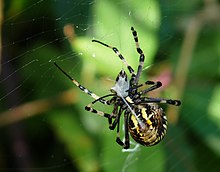

Spider silk is a protein fibre or silk spun by spiders. Spiders use silk to make webs or other structures that function as adhesive traps to catch prey, to entangle and restrain prey before biting, to transmit tactile information, or as nests or cocoons to protect their offspring. They can use the silk to suspend themselves from height, to float through the air, or to glide away from predators. Most spiders vary the thickness and adhesiveness of their silk according to its use.
In some cases, spiders may use silk as a food source.[1] While methods have been developed to collect silk from a spider by force,[2] gathering silk from many spiders is more difficult than from silk-spinning organisms such as silkworms.
All spiders produce silk, although some spiders do not make webs. Silk is tied to courtship and mating. Silk produced by females provides a transmission channel for male vibratory courtship signals, while webs and draglines provide a substrate for female sex pheromones. Observations of male spiders producing silk during sexual interactions are common across widespread taxa. The function of male-produced silk in mating has received little study.[3]
- ^ Miyashita, Tadashi; Maezono, Yasunori; Shimazaki, Aya (2004). "Silk feeding as an alternative foraging tactic in a kleptoparasitic spider under seasonally changing environments" (PDF). Journal of Zoology. 262 (3): 225–29. CiteSeerX 10.1.1.536.9091. doi:10.1017/S0952836903004540.
- ^ Work, Robert W.; Emerson, Paul D. (1982). "An Apparatus and Technique for the Forcible Silking of Spiders". Journal of Arachnology. 10 (1): 1–10. JSTOR 3705113.
- ^ Scott, Catherine E.; Anderson, Alissa G.; Andrade, Maydianne C. B. (August 2018). "A review of the mechanisms and functional roles of male silk use in spider courtship and mating". The Journal of Arachnology. 46 (2): 173–206. doi:10.1636/JoA-S-17-093.1. ISSN 0161-8202. S2CID 53322197.